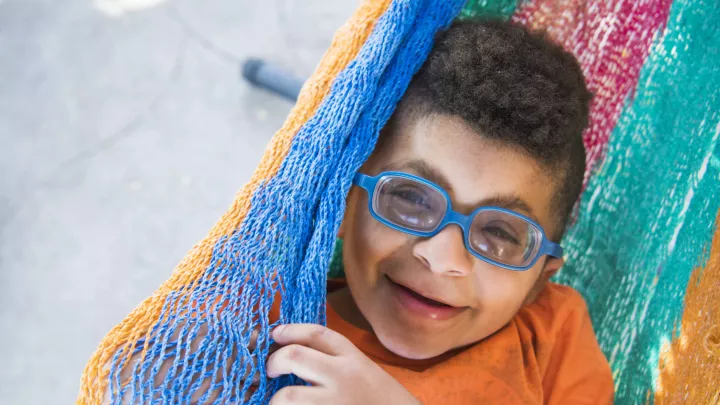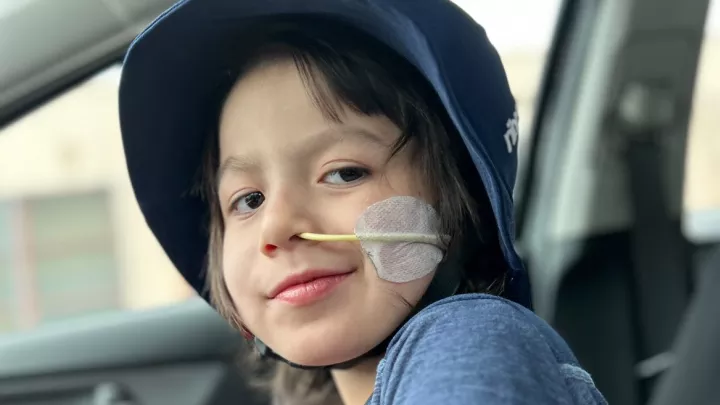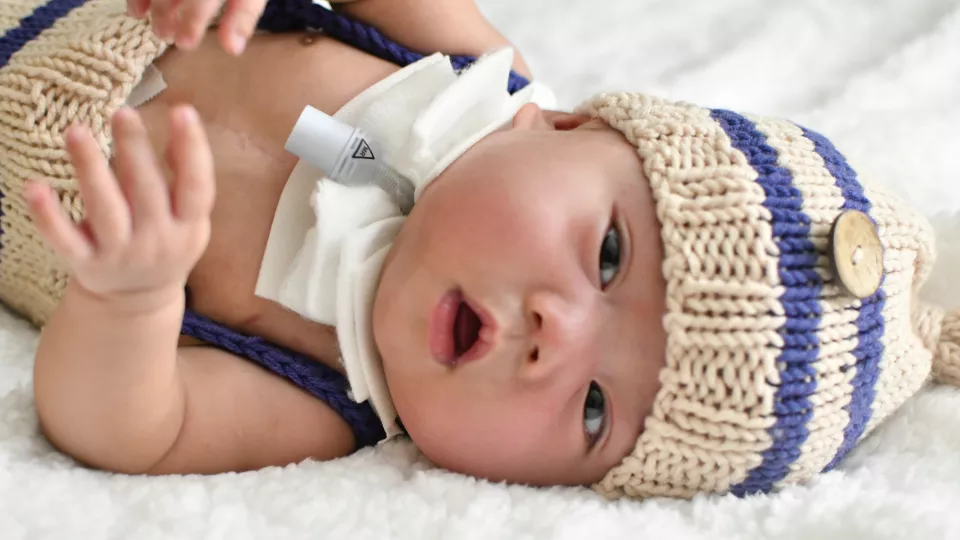
After months in the hospital, Sam underwent a tracheostomy, allowing his parents to take him home.
A Trio of Specialists Help a Preemie Breathe Easy
His voice hoarse, still smoothing itself out from lack of use, Sam, then age 4, at last said what his mother had yearned to hear.
“I couldn’t wait for him to call me Mama,” Lady says. “Normal babies, less than a year old they start saying, ‘Mama, Dada.’ He was 3, 4 years old before he said a word. I got teary-eyed—'I heard you say, “Mama! Mama!” That's what I had been waiting for.”
It came out quick. Even now, at age 6, Sam is learning to pace himself. “When he talks, he talks fast,” Lady says. “We tell him, ‘OK, Sam, relax. Catch your breath first. When we talk, we pause.’ He doesn't know how to pause.”
But that’s understandable; he’s still new at it. Born prematurely at 29 weeks and an ounce short of 2 pounds, Sam spent his entire infancy with tubes installed in his throat and reaching down into his airway, sustaining him when his body was not yet built for it.
Typical of preemies, Sam’s underdeveloped anatomy led to several serious disorders. Multidisciplinary doesn’t quite describe the effort taken by doctors at Children’s Hospital Los Angeles to treat them all. Mega-disciplinary may capture it better, considering how many specialists have taken part in Sam’s care.
“We’ve had a lot of doctors,” his father, Germel, says. “Like from head to toe.”
Seven if you’re counting, each to tackle a condition related to prematurity—cardiologist (congenital heart defect), endocrinologist (low birth weight), gastroenterologist (reflux), neuro-ophthalmologist (impaired vision), neurosurgeon (brain bleed), otolaryngologist (restricted airway), and pulmonologist (chronic lung disease). Add in as well the first five months of his life that Sam spent being treated by the team of specialists in the Newborn and Infant Critical Care Unit (NICCU).
It’s hard to call any of Sam's disorders the primary one, but the one that drew on the largest group of doctors involved an injury to his airway called subglottic stenosis. Fixing it required a collaboration of all three wings of CHLA’s Aerodigestive Program—otolaryngology, pulmonology and gastroenterology—and, typical of preemies, the complexity of the treatment needed to take on one condition bumped against the effort to treat another.
“It's like a house of cards,” says otolaryngologist Christian Hochstim, MD, PhD, who had the central job of repairing Sam’s airway. “You touch one thing and it affects the other, and you have to try to get it all correct. It requires a big team.” Fortunately for Sam, the hospital had one already assembled.
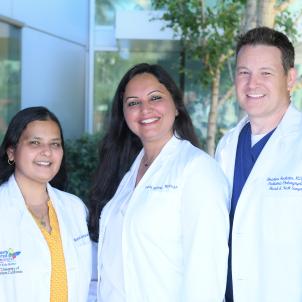
A tag team of endoscopes
Born in December 2017, Sam suffered from chronic lung disease, which is common in premature babies, whose lungs are too weak to perform on their own. A breathing tube, connected to a ventilator, was placed down his throat and into his trachea—the windpipe that carries air to and from the lungs—to support him.
However, the presence of the tube, though necessary, created inflammation and the buildup of scar tissue, causing the space between the vocal cords and the trachea to narrow, impeding Sam’s ability to breathe.
“The opening of his airway was like a pinhole,” Dr. Hochstim says, designating it 95% closed, or Grade 3. That crack of an opening kept the obstruction from being the most severe, a Grade 4.
To build out the airway, Dr. Hochstim would have to perform a laryngotracheal reconstruction, but the procedure had to wait until Sam grew strong enough to endure major surgery. Meanwhile, so he could disconnect from the ventilator and go home, Sam underwent a tracheostomy, wherein a tube is inserted that delivers air directly into the trachea, altogether bypassing the inflamed area just above it.
“The idea was to do the tracheostomy so he could get out of the ICU and start to make developmental progress,” Dr. Hochstim says.
As the date for the reconstructive surgery on Sam’s airway approached, Dr. Hochstim and his fellow co-Medical Directors of the Aerodigestive Program—pulmonologist Manvi Bansal, MD, and gastroenterologist Vrinda Bhardwaj, MD, FAAP—joined in trying to secure a successful outcome.
“Tracheal reconstruction is a very big thing,” Dr. Bansal says. “We were both doing the supporting work for Dr. Hochstim.”
Together, they performed a triple endoscopy, taking turns looking at Sam’s insides to address any weaknesses that, if untreated, could harm Sam’s recovery.
“We're all in the room, but it's a tag team—three different scopes,” Dr. Hochstim says, noting the advantage of doing all three endoscopies together so the patient has to be anesthetized just that one time. “It's a way to look at everything ahead of time, to make sure we feel good about proceeding.”
Dr. Bansal went first, looking to optimize the health of Sam’s lungs so they could sustain him once the tracheostomy tube was removed. “If you don't have strong lungs, you’ll end up needing a trach back in eventually, even though you don't have stenosis in the airway anymore,” she says.
She performed a procedure called a bronchoalveolar lavage, collecting fluid from Sam’s lungs to be tested for infection. The sample came back positive for the presence of bacteria, prompting Dr. Bansal to put Sam on three weeks of antibiotics.
Next up was Dr. Hochstim, who assessed the anatomy of Sam’s airway to determine how best to undertake the reconstruction, and to confirm that it was the only way forward—“to really make sure there were no viable, simpler alternatives,” he says.
Dr. Bhardwaj went third. She searched Sam’s esophagus for any sign of reflux or allergies, a condition called eosinophilic esophagitis (EOE). He was negative for EOE and his moderate reflux was manageable with antacid medications, which is key as uncontrolled reflux can cause postoperative problems. “That constant acid won’t allow healing of the surgical site,” Dr. Bhardwaj explains.
She also took steps to upgrade Sam’s nutritional state, which was deficient even though he was being fed through a gastrostomy tube inserted into his stomach. To strengthen him, Dr. Bhardwaj moved Sam off formula to a food-based, blenderized diet.
“If you’re going in weak to major surgery,” she says, “you’ll run into post-op infections—and you can't fight them.”
Operate, wait, decannulate
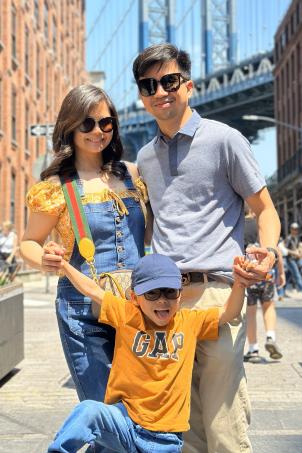
In March 2021, Dr. Hochstim operated on Sam, taking cartilage from his rib and grafting it onto the airway to widen it. The area needed time to heal, so he would wait a year before decannulating—to remove the tracheostomy tube.
During that time, Dr. Hochstim performed regular “surveillance scopes” to confirm the area wasn’t developing scar tissue that would again cause it to narrow. He also had Sam wear a cap on the tracheostomy tube, which made Sam breathe entirely through his rebuilt airway. After Sam showed he could tolerate the cap, a successful sleep study in October 2021 opened the way to decannulation.
“We go slow because we don't want to have a dramatic failure of decannulating and have to put the tube back in,” Dr. Hochstim says. “It took a year to get it out, but when it came out, it was out.”
That was a monumental relief to Germel and Lady as they had to suction and change the tube often to keep it clean and prevent infection, as well as monitor Sam’s sleep in the event the tube got clogged.
“Whenever he had a virus, even just a cough, he didn't sleep and we didn't sleep, because after nonstop coughing, we had to start suctioning,” Lady says. “Now we can rest.”
But as rough a time as it was, it produced one remarkable result. All the while Sam wore the tracheostomy tube, his mother and father used nonverbal communications with him, and with the help of a speech therapist, introduced sign language.
“He learned how to communicate without saying a word,” Germel says. “It takes a learning curve to do it, but if you're doing it for your son, it's easier.”
Because of the effort he and his wife made, Sam’s communication skills at age 6 are much more developed than Germel expected.
“I’m amazed, you know why? He somehow caught up. His teachers and even the principal said he had good communication skills. I was in shock. Given all the hurdles, the surgeries and the setbacks, he’s doing great.”
Unanimous optimism
All three aerodigestive doctors feel good about Sam’s prospects. Dr. Hochstim says a recent study showed the rebuilt airway is stable. “We may periodically scope him to measure the size, but this far out, narrowing doesn’t usually happen again.”
Though chronic lung disease lingers into adulthood, Dr. Bansal says all signs—chest X-rays, blood test, vitamin D levels—indicate his condition is improving.
“Once your airway is fixed, it all depends upon your lungs, and that’s all medication,” she says, noting that Sam gets nebulizer treatments at home to prevent inflammation. “All the acute stuff, it's way behind him. He's gone from somebody who needs help in almost every organ to needing minimal help.”
His eating has improved, as he works toward taking food entirely by mouth. He’s getting there, now at about 30 percent oral feedings, 70 percent through his feeding tube. Dr. Bhardwaj says the largest impediment is the vomiting that eating by mouth caused Sam early in his life.
“There were no good feelings attached to eating,” she says. “He never derived joy out of it, and that’s when oral aversion sets in.”
Delivering blenderized real food through the G-tube is actually intended to wean Sam off it. “If patients eat real food through the tube,” Dr. Bhardwaj says, “it increases their interest in eating real food by mouth as well.”
With all the crises from Sam’s first years starting to ease, his doctors’ optimism is plenty enough for Lady and Germel. They don’t measure him against other kids.
“He has his own timeline,” Lady says. “We're just happy he's getting better. Whenever we go to his doctor's appointments, we see his improvement. He's been through a lot. A lot of surgeries. I cannot even count them anymore. For me, giving birth at 29 weeks, it was a roller coaster. We almost lost him—and we still have him. It’s already a blessing and a bonus for us.”
